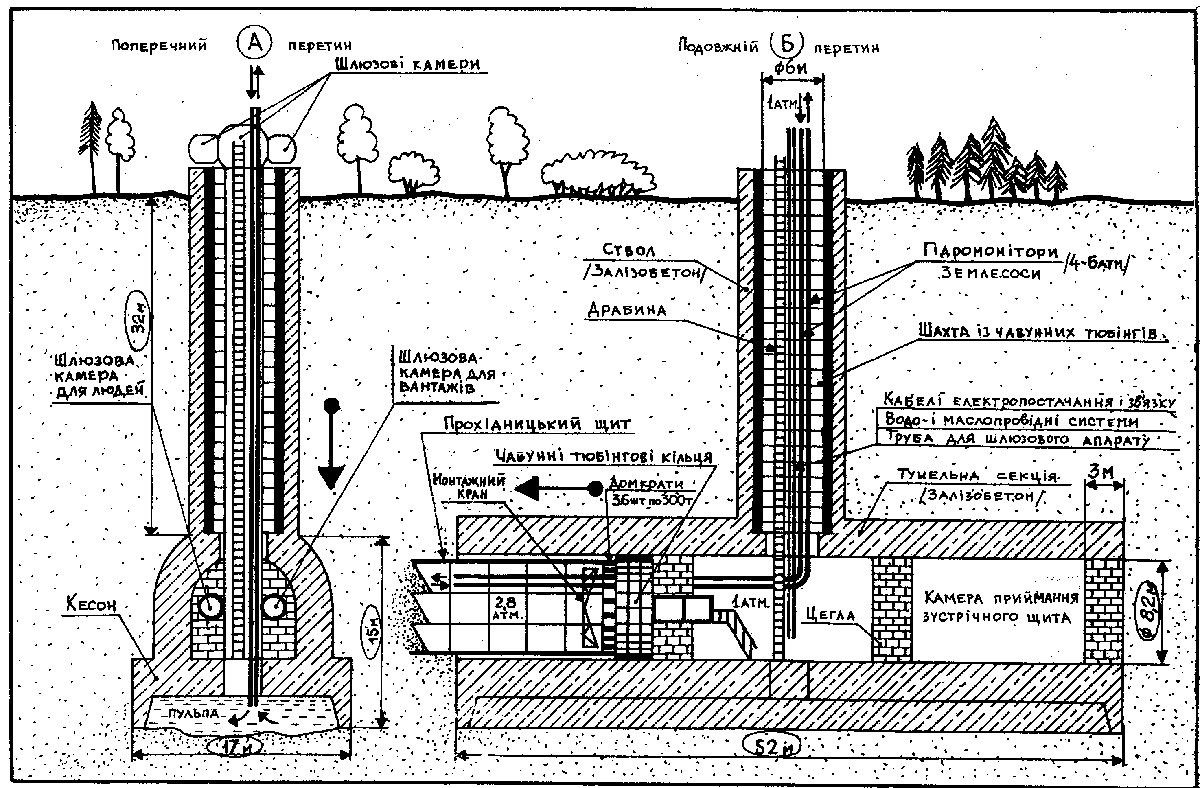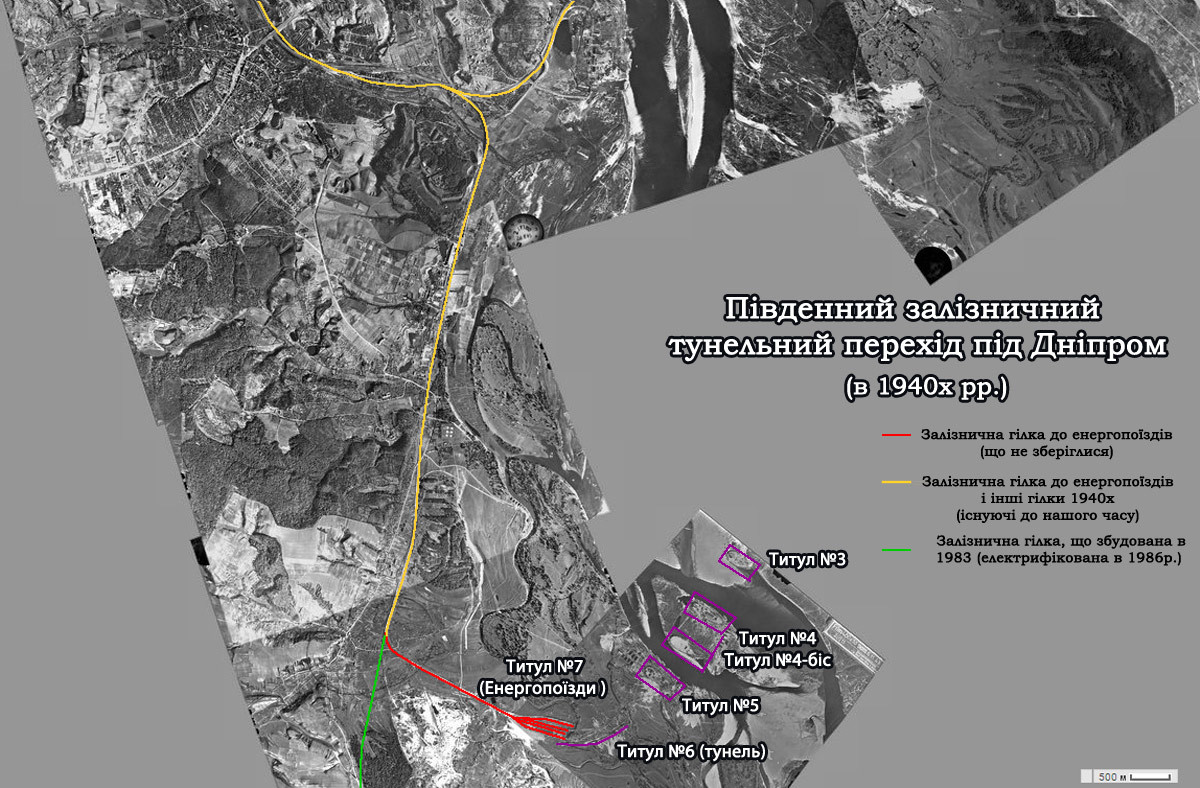The tunnels under the Dnieper, or as they are also called “Stalin Tunnels” (passed in the documents as “Construction No. 1 of the NKPS (People’s Commissariat of Railways of the USSR)”) are unfinished railway tunnels. Work on their construction was carried out in the period from 1938 to 1941, and commissioning was planned for 1944. The project to build tunnels under the Dnieper arose out of military necessity – 2 railway bridges connecting the left and right banks of Kyiv, in the event of war, could be easily destroyed by aircraft, interrupting the supply of ammunition and reinforcements for the units defending the city. Therefore, 2 tunnel crossings were laid under the riverbed: Northern (Obolon – Vigurovshchina) and Southern (Zhukov Island – Osokorki). Construction was carried out in conditions of high secrecy. Small concrete factories, warehouses for equipment, garages for equipment and barracks for workers were built near the construction sites. The workers were forbidden to even tell each other about what they were doing at the construction site – otherwise they would face dismissal or, which happened much more often, a prison sentence. The engineering units of the Red Army (Workers’ and Peasants’ Red Army) and the workers of the Hydroshlyakhbud trust (a total of about 20,000 people) worked on the construction of tunnels under the Dnieper.
This is interesting!
1. In 1941, an accident occurred on one of the tunneling shields, which was moving from Vodnikov Island towards the left bank. Compressed air from the tunnel escaped to the surface of the water and it instantly filled with water. The workers barely managed to escape and after the appointment of a new site manager, repairs to the switchboard began, but the war began. At the end of July of the same year, a command came from Moscow: stop work and mothball construction. The tunneling shields and tunnels were flooded, and other, more valuable equipment was covered with earth in pits.
2. In the tunnels under the Dnieper, they planned to make a system that would cover the rails on top with strong shields, through which cars and military equipment could drive.
3. On Zhukovy Island, the buildings of the rehabilitation center are still preserved, where workers rested and regained their strength.
4. “Stalin’s tunnels” would not have withstood air strikes. The tunnels under the Dnieper were designed to withstand a bomb weighing up to 500 kilograms, while the Luftwaffe had already dropped bombs weighing over 1,500 kilograms.
4. During the construction of the metro in Kyiv, almost all available tubing was removed from the tunnels under the Dnieper, which were then used in the construction of the Vokzalnaya and Polytechnic Institute stations.
5. On the Obolonskaya embankment, in a prominent place and freely accessible, there is an unsubmerged caisson that resembles a ship.
On August 6, 1944, the State Defense Committee of the USSR adopted resolution No. 6326 “On the resumption of construction of the Southern railway tunnel crossing under the Dnieper (construction No. 1 of the NKPS).” The document was classified “top secret” (currently the document is declassified and is stored in the Russian state archive of socio-political history). Water began to be pumped out of the tunnels under the Dnieper, and equipment was dug out of the pits. At the end of 1946, work was in full swing at the already deactivated sites, and on Zhukovy Island the hostel was filled to capacity with workers. But after 4 years, the continuation of Construction No. 1 of the NKPS was considered inappropriate. The remains of this grandiose structure can still be seen on Obolon, Zhukovy Island and Osokorki.
How were tunnels built under the Dnieper?
The tunnel sections were laid using caissons. A caisson is essentially a reinforced concrete box that is turned upside down, with a hole in the bottom. A reinforced concrete tunnel section is cast above it, and water is pumped into the caisson chamber under high pressure, which erodes the earth, sand, and clay with a very powerful jet. The resulting mixture is pumped out and delivered to the surface, from where it is then transported by trucks. The soil is washed away and the caisson, together with the tunnel section, settles down, the shaft increases, forming a shaft lined from the inside with cast-iron tubes that burst the ground under water. When the structure is lowered by 50 meters, horizontal tunneling begins – the earth is squeezed out using a tunneling shield: jacks push it forward, and workers assemble a tunnel ring from cast iron tubes. Pushing off from it, the jacks together with the shield travel about 1 meter per day.
Where are the tunnels under the Dnieper?
Caisson on Obolonskaya embankment: Obolonskaya embankment, 13 (coordinates 50.498797, 30.524665)
Submerged caisson and flooded tunnel on Oskorki: Sadovaya Street, 162 (coordinates 50.365647, 30.611853)
2 caissons and a semi-submerged ground tunnel on Zhukovy Island: Fevralskaya Street, 1/6 (direction Starikovskaya Street) (coordinates 50.335162, 30.575906)













